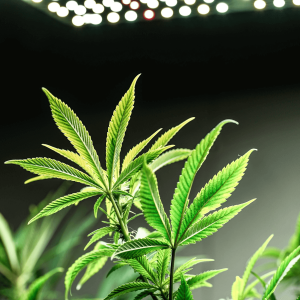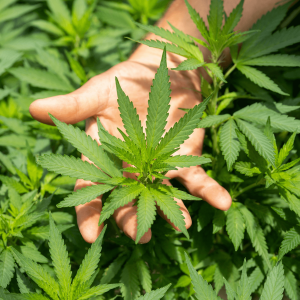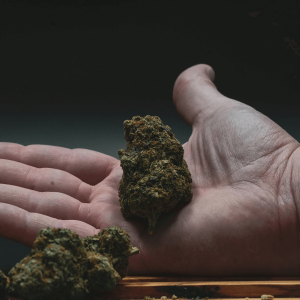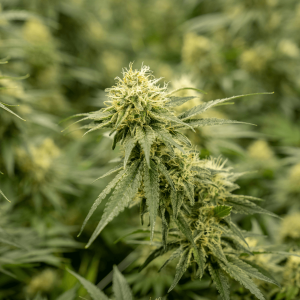Topped plant vs non-topped plants—what’s the big deal? If you’re growing cannabis, understanding the difference is crucial.
Basically, topping is a technique where you trim the main stem of the plant to encourage it to grow more branches, leading to a bushier plant with potentially more buds. On the flip side, a non-topped plant grows in its natural, Christmas tree shape.
Choosing the right method for your cannabis cultivation can impact not just the yield but also the overall plant health and manageability of your plants. In this blog, we’ll break down the differences between topped and non-topped plants, helping you decide which approach is best for your garden.
What is Topping?
Topping is a gardening technique that enables you to get more bang for your buck. In simple terms, it involves cutting off the top part of a plant’s main stem. This might sound counterintuitive, but what it does is encourage the cannabis plant to grow more branches, making it bushier and potentially leading to more buds.
To perform topping, you typically wait until the plant is about 3-5 weeks old and has developed at least 4-6 nodes (the joints where leaves and branches connect to the main stem). Using a clean, sharp pair of scissors, you snip just above the node, sparking new growth from the lower branches.
The practice of topping has been around for ages, with roots in various forms of agriculture and gardening. In the cannabis world, it’s been used for decades as a tried-and-true method to optimize plant structure and boost yields.

Benefits of Topping Cannabis Plants
- Increased yield potential
- Promotion of bushier growth patterns
- Enhanced light distribution and penetration
- Potential for more even nutrient distribution
Drawbacks of Topping Cannabis Plants
While topping has its benefits, it’s not without its downsides. Understanding these drawbacks can help you make a more informed decision about whether topping is right for your cannabis plants.
Possible Stress on the Plant
One of the main concerns with topping is the stress it can place on the cannabis plant. When you cut the main stem, you’re essentially wounding the plant, which can temporarily stifle growth as it works to heal. This stress can sometimes make the plant more susceptible to pests and diseases, although healthy growth, well-cared-for plants usually bounce back quickly.
Extended Vegetative Growth Period
Another thing to keep in mind is that topping can extend the vegetative growth period. Because the plant needs time to recover and reallocate its energy toward new growth, it may take longer to reach maturity. This means you’ll spend more time in the vegetative stage before transitioning to the flowering phase, which can delay your overall harvest timeline.
Risk of Improper Topping Leading to Negative Outcomes
Topping is a technique that requires precision and care. Improper topping can lead to several negative outcomes, such as stunted growth, uneven canopy development, or even permanently damaged plants. Using the wrong tools or cutting at the wrong time can exacerbate these risks, so it’s essential to follow proper topping procedures to avoid these potential pitfalls.
What is a Non-Topped Plant?
A non-topped cannabis plant is simply one that hasn’t undergone the topping process—in other words, it’s left to grow naturally, just as nature intended. These plants typically develop a dominant main stem, often resulting in a classic Christmas tree shape.
The natural growth pattern means the plant will stretch upwards, with a single central cola (the main flowering site) surrounded by smaller side branches. Many cannabis growers opt not to top for various reasons, including simplicity and reduced risk. For some, the less stressful approach appeals, particularly if they want to minimize any potential recovery time or risk of improper cutting.
Additionally, non-topped plants can be less labor-intensive, as they require fewer interventions and allow growers to maintain a more hands-off growing style.
Benefits of Non-Topped Cannabis Plants
- Simplicity and ease of cultivation
- Natural growth leading to potentially larger colas
- Reduction in plant stress and recovery time leading to potentially healthier plants
Drawbacks of Non-Topped Cannabis Plants
While non-topped cannabis plants can offer some benefits, it’s important to be aware of the potential drawbacks as well. This approach may not be suitable for every growing situation, and understanding the limitations can help you make a more informed decision.
Potential for Uneven Light Distribution
One of the primary issues with non-topped plants is the potential for uneven light distribution. Since these plants typically grow in a single, tall, Christmas tree-like structure, the main cola tends to overshadow the lower branches. This shading can prevent lower buds from getting enough light, which could result in smaller and less potent buds. In contrast, a topped plant’s bushier growth allows light to penetrate more evenly throughout the entire plant.
Risk of Lower Overall Yield
Another drawback of non-topped plants is the risk of lower overall yield. While the main central cola may be larger, the lack of multiple top branches means you might miss out on additional flowering sites that can contribute to a higher total yield. Essentially, if your goal is to maximize the amount of cannabis you harvest, non-topped plants may fall short compared to their topped counterparts.
Challenges with Height Management in Indoor Setups
Non-topped plants can also present challenges when it comes to height management, particularly if you’re growing indoors. These plants tend to stretch upwards, which can lead to space issues in grow tents or rooms with limited vertical clearance. Managing the height of a non-topped plant can require additional techniques, such as tying down branches or using other forms of plant training, to keep the plant within an optimal height range for your grow space.

How Topping Can Influence Yield
Topping cannabis plants can make a notable impact on overall yield, often boosting the number of buds produced per plant. By encouraging bushier growth, topping creates a plant structure with multiple colas, each potentially developing into a substantial flowering site.
Case studies and grower reports consistently demonstrate that topped plants tend to yield more compared to non-topped plants. For example, an experienced grower found that topped plants in their garden had a total yield increased by 20% compared to their non-topped counterparts.
Moreover, the flower density and size can be positively influenced by the topping process. By distributing the plant’s energy towards numerous budding sites rather than a single main cola, growers often notice that topped plants produce denser and larger flowers on multiple branches. This can particularly be beneficial in maximizing harvests in both commercial and personal growing environments.
Training Techniques for Topped Plants
Once you’ve topped your cannabis plants, incorporating additional training techniques can help maximize your yield and improve light distribution. Below, we’ll go over a few popular methods to enhance the growth of your topped plants.
Low-Stress Training (LST)
Low-Stress Training (LST) is a gentle method that involves bending and tying down branches to create a more even canopy. This technique allows for better light penetration to all parts of the plant, leading to more uniform bud development. Since LST doesn’t involve cutting, it minimizes stress and recovery time. It’s a great way to optimize the growth of your topped plants, ensuring they get the most light exposure without causing significant stress.
Super Cropping
Super Cropping is a bit more intense and involves slightly damaging the inner tissues of the plant stems by pinching and bending them. This encourages a bushier plant structure and can significantly boost yields by diverting energy from a single main cola to multiple budding sites. While it might sound harsh, many growers find that their plants respond positively to this controlled stress, resulting in stronger and more robust growth.
Screen of Green (ScrOG)
The Screen of Green (ScrOG) technique uses a screen or net to train topped plants to grow horizontally rather than vertically. By weaving the branches through the screen, you can create a wide, even canopy that maximizes light exposure and air circulation. This approach is ideal for indoor growers with limited vertical space, as it helps control plant height and ensures all buds receive adequate light. ScrOG is particularly effective for topped plants, as it accentuates their bushier growth pattern.
Sea of Green (SOG)
Sea of Green (SOG) focuses on growing many small plants instead of a few big ones. This method can be combined with topping to ensure even more vigorous growth and increased yields. In SOG setups, the plants are usually kept in the vegetative stage for a shorter period, leading to a quicker turnover. By topping these smaller plants early, you can create multiple flowering sites that develop quickly, making the most of your space and light resources.

Comparing Growth Patterns: Topped Plant vs. Non-Topped Plant
Topped and non-topped cannabis plants exhibit distinct visual and structural differences that are easily noticeable as they grow.
Topped plants tend to adopt a bushier appearance due to the increased number of side branches and multiple top colas, while non-topped plants retain a more vertical, Christmas tree-like structure with a dominant central cola.
During the vegetative stage, topped plants grow outward, promoting a wider canopy that can catch more light throughout the growing cycle. In contrast, non-topped plants focus their energy on vertical growth, which can limit light penetration to lower branches and result in less uniform bud development.
This variety in canopy structures significantly impacts cultivation strategies, as topped plants often require more techniques like Low-Stress Training (LST) or Screen of Green (ScrOG) to optimize light distribution and space, ultimately leading to potentially higher yields and denser flowers.
Best Practices for Topping
Topping your cannabis plants at the right time and in the right way is crucial for optimizing growth and yield. The best time to perform topping is during the vegetative stage, ideally when the plant has developed 4-6 nodes.
To carry out the topping process, use a pair of sterilized scissors or pruning shears to snip the main stem just above a node. This encourages the plant to grow two new main colas instead of one. It’s important to ensure your tools are clean to prevent infections or diseases.
After topping, keep an eye on the plant’s recovery; providing it with adequate light, water, and nutrients will help minimize stress and promote robust growth. A little patience and care can go a long way in ensuring your topped plants thrive and yield abundantly.
Best Practices for Growing Non-Topped Plants
Growing non-topped plants can be equally rewarding if you follow a few best practices. To maximize light exposure, make sure to position your lights strategically so that even the lower branches receive adequate illumination.
Supporting tall plants is crucial to prevent bending or breaking under the weight of heavy buds; consider using stakes, cages, or trellises for added stability.
Finally, balancing nutrients is essential for optimal growth—ensure your plants receive a well-rounded diet that includes the right amounts of nitrogen, phosphorus, and potassium at different stages of their development for the best results.
Impact on Flowering Stage
When it comes to the flowering stage, topped and non-topped cannabis plants show pretty substantial differences.
For example, topped plants generally take a bit longer to enter full bloom due to the initial recovery period post-topping. However, this delay often leads to a more even and robust bud development, as the plant’s energy is distributed across multiple colas rather than concentrated on a single main cola. This can result in a bushier plant with denser bud clusters.
On the other hand, non-topped plants tend to flower faster since they haven’t undergone the stress of topping. The buds on non-topped plants usually form around the central main cola and are typically larger but fewer in number compared to topped plants.
While the overall potency and quality of the cannabis can be comparable, topped plants might offer a slight edge in cannabinoid and terpene diversity due to the increased number of flowering sites exposed to optimal light conditions.

Choosing Between Topped and Non-Topped
When deciding whether to top your cannabis plants or let them grow naturally, there are several factors to consider based on your experience and goals as a grower.
- For beginners, non-topped plants might be easier to manage, avoiding the additional stress and recovery time associated with topping. However, more experienced cultivators might opt for topping to maximize their yields and enhance the structural integrity of their plants.
- Situational factors also play a crucial role; for instance, indoor growers with limited vertical space often benefit from topping, combined with techniques like ScrOG to maximize light exposure. Conversely, outdoor growers with ample space might prefer non-topped plants, allowing them to reach their full height and make the most of natural sunlight.
- Additionally, certain strains respond better to topping, especially those known for vigorous side branching, while others may naturally grow bushier without any intervention. Resource availability—such as time, tools, and knowledge—also informs this decision.
To make a quick decision, consider these pros and cons:
- Topped plants often yield more, create bushier structures, and enhance light distribution but require more time, skill, and recovery.
- Non-topped plants are simpler to manage, grow faster, and maintain a classic Christmas tree shape but might result in uneven light distribution and lower overall yields.
Ultimately, it’s important to choose the method that aligns best with your growing situation and personal goals to achieve a successful harvest.
Conclusion
In summary, the decision to top your cannabis plants or grow them naturally depends on your specific goals and growing conditions.
Topped plants offer the benefits of increased yields, bushier structures, and better light distribution but require more skill, time, and recovery. Non-topped plants are simpler to manage, grow faster, and maintain a classic shape, though they may result in less efficient light distribution and potentially lower yields.
Ultimately, both techniques have their advantages, and the best way to determine what works for you is through experimentation. Don’t be afraid to try different methods and observe how your plants respond. With the convenience of cannabis delivery services, you can easily obtain the necessary supplies to experiment and refine your growing techniques. This hands-on experience will help you become a better grower and achieve a bountiful harvest.

Frequently Asked Questions
1. Is topping plants worth it?
Topping can be worth it if you’re looking to maximize your plant’s yield and improve light distribution. This technique encourages the growth of multiple colas, leading to bushier plants with potentially denser buds. However, topping requires a bit more skill and time for the plant to recover, so it might not be the best choice for beginners or those with limited time.
2. What is the difference between topped and non-topped Autoflower plants?
Topped autoflower plants may take a bit longer to hit their flowering stride due to the recovery time needed after topping. They might also be bushier and have a more even distribution of flowers. On the other hand, non-topped autoflower plants typically grow faster and maintain a classic main cola with fewer but possibly larger buds. It’s also worth noting that some autoflower strains are more resilient to topping than others, so researching your specific strain can be beneficial.
3. What does it mean when a plant is topped?
Topping a plant means cutting off the main stem just above a node to encourage the growth of two new main colas instead of one. This method redirects the plant’s energy, resulting in a bushier structure with more flowering sites. It’s a common technique used to improve light distribution and potentially increase yield in cannabis cultivation.
4. Does topping a plant increase yield?
Yes, topping a plant can increase yield by promoting the growth of multiple colas, resulting in more bud sites. This technique helps maximize the plant’s exposure to light and distribute energy more evenly, which can lead to denser and more robust flowers. While there is an initial recovery period, the potential benefits in yield and plant structure often outweigh the time spent on recovery.

 Rewards
Rewards




